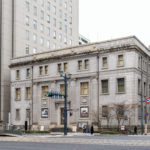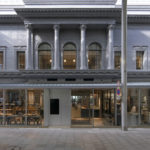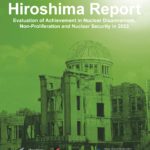Column Moto-machi: Visiting a Drastically-altered Urban Space
Introduction
The history of the Hiroshima delta is said to have started in 1589 with the construction of Hiroshima Castle by Terumoto Mori, a Warring States period daimyo (feudal load). The grounds of Hiroshima Castle were roughly one kilometer from east to west and one kilometer from north to south, with a total area of approximately 900,000 square meters. It was a robust castle constructed on flat land with three moats and 88 guard towers. In 1872, this area was named “Moto-machi,” meaning the “foundation town,” as the castle area was deemed to be the land upon which the foundation for Hiroshima was laid. 1) Moto-mach, from the Meiji period up until the atomic bombing, was the embodiment of a military city, housing the Fifth Division Headquarters, the Western Drill Ground, and other military city, housing the Fifth following the war, some hastily built public housing lined the area, but now it is the site of the prefectural government offices, local divisions of the national government, museums, libraries, gymnasiums and other cultural and sports facilities, as well as low, middle and high-rise residential complexes. It has completely transformed into a representative urban center of the city of Hiroshima. This column will investigate the trajectory of change the area has seen, looking at the traces of the past that overlap with the present and still remain today.
1 Becoming a Provisional Capital
In the south of the east wing of the Hiroshima prefectural government office, there is a plaque, indicating the former site of the Provisional Imperial Diet Building. It explains that in the First Sino-Japanese War, which began in August 1894, the Imperial Headquarters were moved to Hiroshima, and Provisional Imperial Diet was opened. Once the war began, as home of the Fifth Division, Hiroshima City became the launching point for troops to the continent. The opening of Ujina Port and the Sanyo Railway were important factors in this. Then, in September, the Imperial Headquarters were moved from the General Staff Office in Tokyo to the Fifth Division Headquarters were moved from the General Staff Office in Tokyo to the Fifth Division Headquarters in Hiroshima Castle. On October 15, the Provisional Imperial Diet convened in Hiroshima to discuss the temporary military spending budget and other war-related bills.3) In preparation for this, a western-style, one-floor, wooden shingle-roofed Provisional Diet Building was quickly constructed on the Western Drill Ground.4) With the Imperial Headquarters and the Imperial Diet moved to Hiroshima, the Meiji Emperor, government officials, military officials, and members of the House of Peers and the House of Representative came to Hiroshima one after the other. Following the start of the First Shino-Japanese War, Hiroshima seemed to be exactly what one would expect of a provisional capital.5)
2 Hiroshima Castle’s Other Moat and a New Downtown
North of the center plaza of Kamiya-cho’s underground mall (Shareo), at the bottom of the staircase that leads up to the office of the Prefectural Government, there remains some masonry which was part of the outer moat of Hiroshima Castle. This stone wall was dug up during the construction of the underground mall. The east-west road at the Kamiya-cho intersection (present Aioi Street) was once the outer moat of the south side of Hiroshima Castle. During the Meiji period, sewage stagnated in the outer moat, and gave off an awful odor in summer. In the rainy seasons of spring and fall, the waters would overflow and cause infectious diseases to spread.6) To counteract this, the City set a land reclamation plan for the outer moat, taking over jurisdiction from the Ministry of Army. Finally, in 1911 the moat was converted into plazas, some roads and residential areas. At the same time, streetcar tracks converted into plazas, some roads and residential areas. At the same time, streetcar tracks were laid down, and the first streetcar line opened in November 1912.7) The opening of the streetcar system helped facilitate transportation, and Hatchobori, Shintenchi, and the area surrounding Hiroshima Station developed into bustling downtown areas.
3 The Atomic Bomb: Destruction of the City Originating from Hiroshima Castle
Along the southern end of the Hiroshima Castle’s main compound, along the stone wall of the inner moat there are remains of semi-subterranean reinforced concrete. At the time of the bombing, it was part of a military facility known as the Chugoku Military District Headquarters’ Air Defense Room. It was used as a strategic and intelligence operation headquarters in case of air raids, and was equipped with a vault for important documents. Starting from May 1945, 90 third-year students of Hijiyama Girls’ High School were mobilized there. Working in three shifts, they carried out telephone operations. They were there when the atomic bomb hit. The Chugoku Military District Headquarters building was destroyed instantaneously. This was followed by outbreaks of fires. The former Imperial Headquarters building and the castle tower on upper levels of the compound collapsed but escaped the fires. The Hijiyama Girls’ High School students who were in the semi-subterranean Air Defense Room were blown by the bomb’s blast. Still, these girls managed to make use of the one dedicated line that could still be used, and quickly got the message of Hiroshima’s destruction to those outside the city, while all communications and phone lines in the city were destroyed. 8)
Today, near the entrance to the former Air Defense Room, there is a monument in remembrance of the military service members, civilian employees, and mobilized students who lost their lives there.
4 The Phantom Hiroshima Station Relocation Plan
In the postwar reconstruction plans, there was a proposal to move Hiroshima Station to Moto-machi (the former site of the Western Drill Ground). Moving the station was one of the major challenges faced by the city, and it emerged as part of an effective plan for utilizing the former Western Drill Ground. However, the costs would have been far too great, and the proposal was left to fade into obscurity.9) However, in the Hakushima district near Moto-machi there is progress being made on constructing new stations at the JR Sanyo Line and the Astram Line crossing. Though it has changed somewhat, the planner’s dream of having a train station at the city center is becoming a reality.
5 Emergency Housing and Moto-machi
In the war damage reconstruction plan, the western side of the former military site in Moto-machi was to be used mostly for park land. However, in measures to counteract the lack of residences, the Housing Corporation and the city and prefectural governments built emergency housing in this area. By 1948, there were 851 city homes and three buildings (wooden two-floor apartments), and by 1949 the Housing Corporation, Hiroshima Prefecture, and the City of Hiroshima had built a total of 1,800 homes in this area.10)
The homes made by the Housing Corporation were such simple constructions, for which the materials were shipped to each site from factories, that even amateur should build them within two or three days. In other parts, of the city too, public housing was built, but there was a flood of applications. Lotteries where held, and they were highly competitive.11) Public housing in Moto-machi went on to age quickly, and illegal constructions began to arise along the banks of the Ota River.
The housing situation was finally resolved through the redevelopment project, which was completed in 1978. And the riverbanks, once clustered with illegal constructions, have now been transformed into the Moto-machi Environmental Riverbank, a hydrophilic waterfront space.12)
(Kazuhiko Takano and Hitoshi Nagai)
Notes
1. City of Hiroshima (Ed.). Shinshu Hiroshima Shishi: Dai Ni Kan (History of the City of Hiroshima: New Edition, Vol. 2). City of Hiroshima, 1958: p 442.
2. City of Hiroshima (Ed.). Hiroshima Shinshi: Zaisei Hen (History of Postwar Hiroshima: Finance). City of Hiroshima, 1983: pp. 213 –216.
3. City of Hiroshima (1958). op. cit., pp. 521 – 523.
4. Hiroshima Prefecture (Ed.). Hiroshima Rinsenchi Nisshi (Record of Hiroshima in the First Sino-Japanese War). Hiroshima Prefecture, 1899; Reprinted Ed., Keisui-sha, 1984: p. 235.
5. City of Hiroshima (Ed.). Shinshu Hiroshima Shishi: Dai Ikkan (History of the City of Hiroshima: New Edition, Vol. 1). City of Hiroshima, 1961: pp. 455 – 457.
6. City of Hiroshima (1958). op. cit., pp. 607–608.
7. Hiroshima Dentetsu Shashi Hensan Iinkai (Ed.). Hiroshima Dentetsu Kaigyo Hyaku Nen Soritsu Nanaju Nenshi (History of Hiroshima Electric Railway 100 Years in Business, History of 70 Years since Founding). Hiroshima Electric Railway, 2012: p. 43.
8. Kyu Hijiyama Kojo Dai Gokisei no Kai (Ed.). Honoo no Naka ni – Genbaku de Itta Kyuyu no Nijugokaiki ni Yosete (In the Flames – For the Memorial Day of Our Classmates who Passed with the A-Bomb 25 Years Ago). Kyu Hijiyama Kojo Dai Gokisei no Kai, 1969: pp.
29 – 31. City of Hiroshima (Ed.). Hiroshima Genbaku Sensaishi: Dai Ni Kan (Record of the Hiroshima A-bomb War Disaster, Vol. 2).City of Hiroshima, 1971: pp. 166 – 168.
Hiroshima Castle (Ed.). “Hiroshimajo Kaimetsu!–Genbaku Higai no Jittai” (The Destruction of Hiroshima Castle!–The Realities of the A-Bomb Damage). (An exhibition catalog). Hiroshima Castle, 2010: pp. 75 – 78.
9. City of Hiroshima (Ed.). Hiroshima Shinshi: Shiryo Hen II, Fukko Hen (History of Postwar Hiroshima: Resource Materials Vol. II, Reconstruction). City of Hiroshima, 1982: pp. 18 – 19, 26 – 27, 35, 48.
10. City of Hiroshima (Ed.). Shisei Yoran, Showa Nijusan Nen Ban (The Municipal Handbook, 1948 edition). City of Hiroshima, 1949: pp. 83 – 84.
Hiroshima Peace Memorial Museum. “Moto-machi – Sugata o Kaeru Hiroshima Kaiki no Chi” (“Moto-machi: At the Heart of Hiroshima’s Changes”) (an exhibition catalog). Hiroshima Peace Memorial Museum, 2012: p. 10.
11. City of Hiroshima (Ed.). Hiroshima Shinshi: Shimin Seikatsu Hen (History of Postwar Hiroshima: Civil Life). City of Hiroshima, 1983: pp. 55 – 59.
Hiroshima Toshi Seikatsu Kenkyu Kai (Ed.). Hiroshima Hibaku Yonju Nenshi, Toshi no Fukko (Reconstruction of HIROSHIMA, Pictorial History of Forty Years since Atomic Boming). City of Hiroshima, 1985: pp. 70 – 71.
12. Hiroshima Toshi Seikatsu Kenkyu Kai (Ed.). Hiroshima – Toshibi Zukuri Kono Ju Nen: Fukei no Sozo e (Hiroshima – 10 Years of Urban Beautification, Creating the Landscape). City of Hiroshima, 1989: pp. 80 – 85.







